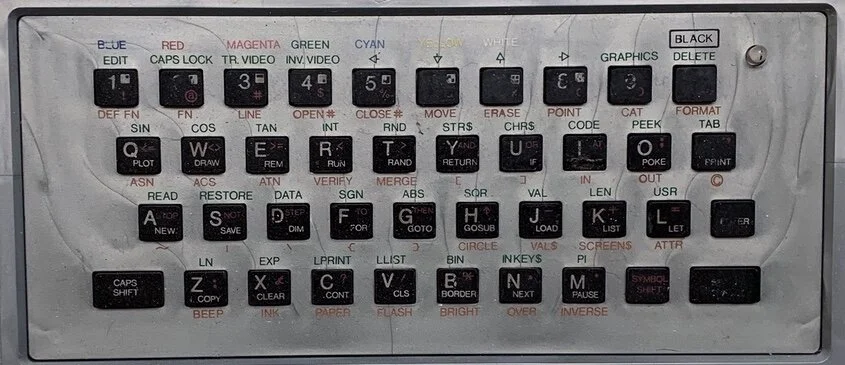They should have called this the T-34, because it's built like a tank.
Iron Curtain Clones - part 2
Like me, I’m sure you’re looking at the picture above and thinking, “So what? It’s a Spectrum”. But look closely, and you’ll see that this, in fact not what it seems. Maybe, after some more scrutiny, you’ll spot the tiny mistake that exposed this cunning clone for the fiendish fraud that it is…
OK, I’ll put you out of your misery. They misspelled the manufacturer's name. It should be SinclAIr! But they almost had me there.
OK, enough silliness. The only thing that makes this like a Spectrum (from the outside) is that it says ZX Spectrum on it. I can’t find much information on this thing, but I believe it’s from the USSR and is probably a Leningrad 1 from around 1988. I can’t find any information on the Yaguana label, so I’m not sure if that was who manufactured it.
So let’s take a look at this thing. First of all, the case is all metal with a shiny black finish (enamel?). This makes this thing HEAVY. Given its size (more on that later), I was shocked to see that this thing weighs in at 2lbs 6oz, about 1.1 kg. That’s double the weight of a Spectrum, a svelte 1lb 3oz, or 546 grams.
You don’t want to drop this on your toes.
There are some ventilation slots to the right of the XZ Spectrum label (it’s some kind of printing rather than a sticky label), so this thing may have given off a fair amount of heat. On the far right is the Yaguana label, which is a paper label.
Below that is the keyboard, and it’s quite a keyboard. The keys are square, cream-colored plastic, and are slightly concave from side to side. They don’t feel bad under your fingers, but you can feel the sides of the keys rub against each other when you type, which doesn’t enhance the experience. The Q key on mine is sitting lower than all the other keys, although it still has some travel. I’ve not disassembled the keyboard to investigate the cause.
The keys have foil stickers on them. The majority have been placed neatly on the keys, but some are decidedly off. In some cases, like the Break/Space key, it looks like the label was originally in the right place based on the adhesive residue, but has moved. I wonder if the frantic game playing made the adhesive warm enough that the label could slide across the key.
The key labels are OK, but the choice to use black text on a color background on the top and bottom of the labels means that the font is very small and not particularly easy to read. The black test on the red background is particularly bad. That being said, given that each of the “regular” keys has five separate items printed on them, it’s hard to complain too much. Unlike the Spectrum which had a mere three items on each key and the other two functions printed above and below the key, there’s no space between the keys so it all has to fit on there.
Yes, I do need to dust my computers.
The Spectrum+ put everything on the key and didn’t even bother with color, but they also had much larger keycaps, and the raised concave part of the key, to help divide things up.
Yep. Dusty.
There’s a very odd difference between the keyboard layout on the Leningrad and the Spectrum. The colors are listed above the number keys in both cases, but they’re listed in a different order.
The sequence for the Spectrum is blue, red, magenta, green, cyan, yellow, white, and black. On the Leningrad, it’s blue, red, magehta (sic), cyan, yellow, white, green, and black. I have to wonder if the colors were actually in a different order, or if it was an error on the keyboard. It would be strange to modify the key assignments of the colors in ROM, given that this was supposed to be a clone.
As I mentioned earlier, here’s a look at the size of the Leningrad in comparison to the Spectrum. Obviously, it’s bigger in all dimensions, but the weight of the Leningrad still comes as a surprise when you pick it up, especially since the Spectrum is fairly weighty for its size.
This must have been a noisy computer. Check out all that DIN. Ahem.
Round the back, and it’s a lovely array of DIN connectors. First up is a joystick connector. It’s not a Kempston or Sinclair connector, so I’m assuming there must have been third-party joysticks available. The video connector also isn’t a standard I recognize. The only DIN I’ve seen for video is S-Video’s mini-DIN. The tape connector is the same connector type as the video. To the right of that is a second joystick port. It’s the same connector as joystick-1, so I’m assuming it’s the same type. Next to that is a hardware reset button, which is decidedly to the left of the label on the back of the case. Finally, there’s a +5v power connector, which worryingly uses the same connector type as the video and tape. I'm not sure what would happen if you accidentally connected the power cable to either, but I can’t imagine it would be good.
Although it’s a rather odd collection, the addition of two joystick ports and a reset button make it something a Spectrum owner would be happy to have.
Underneath, there’s not much to see. My model is missing three of the four case screws. The label was mostly gone and actually ended up getting completely removed when I was trying to clean the case. There are another two sets of ventilation slots, so maybe this thing had some cooling problems.
Inside is a bit of a mystery to me. I’m guessing the long chip in the center is the Z80 or equivalent. The wider chip to the left of that seems to be an EEPROM, based on a quick Google search. If you were hoping for an in-depth look at the innards, I’m sorry.
So, that’s part 2 of the series on computers from behind the Iron Curtain. I hope you found it interesting.













